A Sediment Diagenesis Model of Seasonal Nitrate and Ammonium Flux Spatial Variation Contributing to Eutrophication at Taihu, China
Abstract
1. Introduction
2. Materials and Methods
2.1. The Research Area
2.2. The Role of the Environmental Fluid Dynamics Code
2.3. Principles of Diagenesis Fluxes
2.4. Constructing the Sediment Diagenesis of Nitrate (NO3), Ammonium–Nitrogen Flux Model
2.5. Data Recording Stations
3. Results
3.1. Seasonal Variation of Nitrate (NO3) Flux Analysis
3.2. Seasonal Variation of Concentration Ammonium–Nitrogen (Conc. NH4–N) Analysis
3.3. Calibration of the Lake Taihu Sediment Diagenesis Model with the Water Quality Model
4. Discussion
5. Conclusions
Author Contributions
Funding
Acknowledgments
Conflicts of Interest
References
- Jiang, L.; Li, Y.; Zhao, X.; Tillotson, M.R.; Wang, W.; Zhang, S.; Sarpong, L.; Asmaa, Q.; Pan, B. Parameter uncertainty and sensitivity analysis of water quality model in Lake Taihu, China. Ecol. Model. 2018, 375, 1–12. [Google Scholar] [CrossRef]
- Emerson, S.; Hedges, J. Sediment diagenesis and benthic flux. Treatise Geochem. 2003, 6, 293–319. [Google Scholar]
- Hu, W.; Chen, Y. Sediment resuspension in the lake Taihu, China. Chin. Sci. Bull. 2014, 41, 420–425. [Google Scholar] [CrossRef]
- Chunhua, H.; Weiping, H.; Fabing, Z.; Zhixin, H.; Xianghua, L.; Yonggen, C. Sediment resuspension in the lake Taihu, China. Chin. Sci. Bull. 2006, 51, 731–737. [Google Scholar]
- Dzialowski, A.R.; Wang, S.; Lin, N.-C.; Beury, J.H.; Huggins, G.D. Effects of sediment resuspension on nutrient concentrations and algal biomass in reservoirs of the central plains. Lake Reservioirs Manag. 2008, 24, 313–320. [Google Scholar] [CrossRef]
- Sobek, S.; Zurbru, R.; Ostrovsky, I. The burial efficiency of organic carbon in the sediments of lake kinneret. Aquat. Sci. 2011, 73, 355–364. [Google Scholar] [CrossRef]
- Hansen, P.S.; Phlips, E.J.; Aldridge, F.J. The effects of sediment resuspension on phosphorus available for algal growth in a shallow subtropical lake, lake okeechobee. Lake Reservioirs Manag. 1997, 13, 154–159. [Google Scholar] [CrossRef]
- Kaiser, D.; Kowalski, N.; Böttcher, M.E.; Yan, B.; Unger, D. Benthic nutrient fluxes from mangrove sediments of an anthropogenically impacted estuary in southern china. Mar. Sci. Eng. 2015, 3, 466–491. [Google Scholar] [CrossRef]
- Di Toro, D.M.; Fitzpatrick, J.J. Chesapeake Bay Sediment Flux Model; U.S. Army Corps of Engineers, Waterways Experiment Station: Vicksburg, MS, USA, 1993.
- McCulloch, J.; Gudimov, A.; Arhonditisis, G.; Chesnyuk, A.; Dittrich, M. Dynamics of p-binding forms in sediments of a mesotrophic hard-water lake: Insights from non-steady state reactive-transport modeling, sensitivity and identifiability analysis. Chem. Geol. 2013, 354, 216–232. [Google Scholar] [CrossRef]
- Li, L.; Ni, J.; Chang, F.; Yue, Y.; Frolova, N.; Magritsky, D.; Borthwick, A.G.L.; Ciais, P.; Wang, Y.; Zheng, C.; et al. Global trends in water and sediment fluxes of the world’ s large rivers. Sci. Bull. 2019, 65, 62–69. [Google Scholar] [CrossRef]
- Policelli, F.; Hubbard, A.; Jung, H.C.; Zaitchik, B. A predictive model for lake chad total surface water area using remotely sensed and modeled hydrological and meteorological parameters and multivariate regression analysis. J. Hydrol. 2018, 568, 1071–1080. [Google Scholar] [CrossRef]
- Duan, L.; Song, J.; Liang, X.; Yin, M.; Yuan, H.; Li, X. Dynamics and diagenesis of trace metals in sediments of the changjiang estuary. Sci. Total Environ. 2019, 675, 247–259. [Google Scholar] [CrossRef] [PubMed]
- Binding, C.E.; Greenberg, T.A.; McCullough, G.; Watson, S.B.; Page, E. An analysis of satellite-derived chlorophyll and algal bloom indices on lake winnipeg. J. Great Lakes Res. 2018, 44, 436–446. [Google Scholar] [CrossRef]
- Watson, S.B.; Miller, C.; Arhonditsis, G.; Boyer, G.L.; Carmichael, W.; Charlton, M.N.; Confesor, R.; Depew, D.C.; Hook, T.O.; Ludsin, S.A.; et al. The re-eutrophication of lake erie: Harmful algae blooms and hypoxia. Harmful Algae 2016, 56, 44–66. [Google Scholar] [CrossRef] [PubMed]
- Qin, B.; Xu, P.; Wu, Q.; Luo, L.; Zhang, Y. Environmental issues of lake taihu, china. Hydrobiologia 2007, 58, 3–14. [Google Scholar]
- Gao, L.; Zhou, J.M.; Yang, H.; Chen, J. Phosphorus fractions in sediment profiles and their potential contributions to eutrophication in dianchi lake. Environ. Geol. 2005, 48, 835–844. [Google Scholar] [CrossRef]
- Huang, J.; Zhang, Y.; Huang, Q.; Gao, J. When and where to reduce nutrient for controlling harmful algal blooms in large eutrophic lake chaohu, china? Ecol. Indic. 2018, 89, 808–817. [Google Scholar] [CrossRef]
- Kim, D.; Zhang, W.; Watson, S.; Arhonditsis, G. A commentary on themodelling of the causal linkages among nutrient loading, harmful algal blooms, and hypoxia patterns in lake erie. J. Great Lakes Res. 2014, 40, 117–129. [Google Scholar] [CrossRef]
- Yadav, N.; Kour, D.; Yadav, A.N. Microbiomes of freshwater lake ecosystems. J. Microbiol. Exp. 2018, 6, 245–248. [Google Scholar] [CrossRef][Green Version]
- Nwankwegu, A.S.; Li, Y.; Huang, Y.; Wiei, J.; Norgbey, E.; Sarpong, L.; Lai, Q.; Wang, K. Harmful algal blooms under changing climate and constantly increasing anthropogenic actions: The review of management implications. 3 Biotech 2019, 9, 449. [Google Scholar] [CrossRef]
- Pena, M.A.; Katsev, S.; Oguz, T.; Gilbert, D. Modeling dissolved oxygen dynamics and hypoxia. Biogeosciences 2010, 7, 933–957. [Google Scholar] [CrossRef]
- Katsev, S.; Dittrich, M. Modeling of decadal scale phosphorus retention in lake sediment under varying redox conditions. Ecol. Modell. 2013, 251, 246–259. [Google Scholar] [CrossRef]
- Tang, G.; Zhu, Y.; Wu, G.; Li, J.; Li, Z.-L. Modelling and analysis of hydrodynamics and water quality for rivers in the northern cold region of china. Int. J. Environ. Res. Public Health 2016, 13, 408. [Google Scholar] [CrossRef] [PubMed]
- Qin, B.; Xu, P.; Wu, Q.; Luo, L.; Zhang, E.Y. Environmental issues of lake Taihu, China. In Eutrophication of Shallow Lakes with Special Reference to Lake Taihu, China; Springer: Dordrecht, The Netherlands, 2007. [Google Scholar]
- Deng, B.; Liu, S.; Xiao, W.; Wang, W.; Jin, J.; Lee, X. Evaluation of the clm4 lake model at a large and shallow freshwater lake. J. Hydrometeorol. 2013, 14, 636–649. [Google Scholar] [CrossRef]
- Janssen, A.B.G.; Jager, V.C.L.D.; Janse, J.H.; Kong, X.; Liu, S.; Ye, Q.; Mooij, W.M. Spatial identification of critical nutrient loads of large shallow lakes: Implications for lake Taihu (China). Water Res. 2017, 119, 276–287. [Google Scholar] [CrossRef] [PubMed]
- Huo, S.; He, Z.; Ma, C.; Zhang, H.; Xi, B.; Zhang, J.; Li, X.; Wu, F.; Liu, H. Spatio-temporal impacts of meteorological and geographic factors on the availability of nitrogen and phosphorus to algae in chinese lakes. J. Hydrol. 2019, 572, 380–387. [Google Scholar] [CrossRef]
- Liang, S.; Wu, H.; Li, H.; Wu, Y. Assessment of the spatial and temporal water eutrophication for lake baiyangdian based on integrated fuzzy method. J. Environ. Prot. 2013, 4, 120–125. [Google Scholar] [CrossRef]
- Wu, T.; Qin, B.; Brookes, J.D.; Yan, W.; Ji, X.; Feng, J. Spatial distribution of sediment nitrogen and phosphorus in lake taihu from a hydrodynamics-induced transport perspective. Sci. Total Environ. 2019, 650, 1554–1565. [Google Scholar] [CrossRef]
- Kämpf, J. Wind-driven overturning, mixing and upwelling in shallow water: A nonhydrostatic modeling study. J. Mar. Sci. Eng. 2017, 5, 47. [Google Scholar] [CrossRef]
- Zhang, Y.; Qin, B.-Q.; Zhu, G.; Gao, G. Effect of sediment resuspension on underwater light field in shallow lakes in the middle and lower reaches of the yangtze river: A case study in Longgan lake and Taihu lake. Sci. China Ser. D 2014, 49, 114–125. [Google Scholar] [CrossRef]
- Tech, T. The environmental fluid dynamics code theory and computation: Sediment and contaminant transport and fate. Tetra. Tech. Inc. 2008, 2, 635–639. [Google Scholar]
- Chen, Y.; Zou, R.; Su, H.; Bai, S.; Faizullabhoy, M.; Wu, Y. Development of an integrated water quality and macroalgae simulation model for tidal marsh eutrophication control decision support. Water 2017, 9, 277. [Google Scholar] [CrossRef]
- Taylor, P.; Li, Y.; Tang, C.; Zhu, J.; Pan, B.; Anim, D.O.; Ji, Y. Parametric uncertainty and sensitivity analysis of hydrodynamic processes for a large shallow freshwater lake parametric uncertainty and sensitivity analysis of hydrodynamic processes for a large shallow freshwater lake. Hydrol. Sci. J. 2015, 60, 1078–1095. [Google Scholar]
- Khalil1, K.; Raimonet, M.; Laverman, A.M.; Yan, C.; Andrieux-Loyer, F.; Viollier, E.; Deflandre, B.; Ragueneau, O.; Rabouille, C. Spatial and temporal variability of sediment organic matter recycling in two temperate eutrophicated estuaries. Aquat. Geochem. 2013, 19, 517–542. [Google Scholar] [CrossRef]
- Niemistö, J.; Kononets, M.; Ekeroth, N.; Tallberg, P.; Tengberg, A.; Hall, P.O.J. Benthic fl uxes of oxygen and inorganic nutrients in the archipelago of gulf of finland, baltic sea—Effects of sediment resuspension measured in situ. J. Sea Res. 2018, 135, 95–106. [Google Scholar] [CrossRef]
- Nwankwegu, A.S.; Li, Y.; Huang, Y.; Wei, J.; Norgbey, E.; Lai, Q.; Sarpong, L.; Wang, K.; Ji, D.; Yang, Y.; et al. Nutrient addition bioassay and phytoplankton community structure monitored during autumn in xiangxi bay of three gorges reservoir, china. Chemosphere 2020, 247, 125960. [Google Scholar] [CrossRef] [PubMed]
- Paerl, W.H.; Fulton, S.R.; Moisander, P.H.; Dyble, J. Harmful freshwater algal blloms, with an empahsis on cyanobacteria. Sci. World 2001, 1, 76–113. [Google Scholar] [CrossRef] [PubMed]
- Manning, N.F.; Wang, Y.; Long, C.M.; Bertani, I.; Sayers, M.J.; Bosse, K.R.; Shuchman, R.A.; Scavia, D. Extending the forecast model: Predicting western lake erie harmful algal blooms at multiple spatial scales. J. Great Lakes Res. 2019, 45, 587–595. [Google Scholar] [CrossRef]
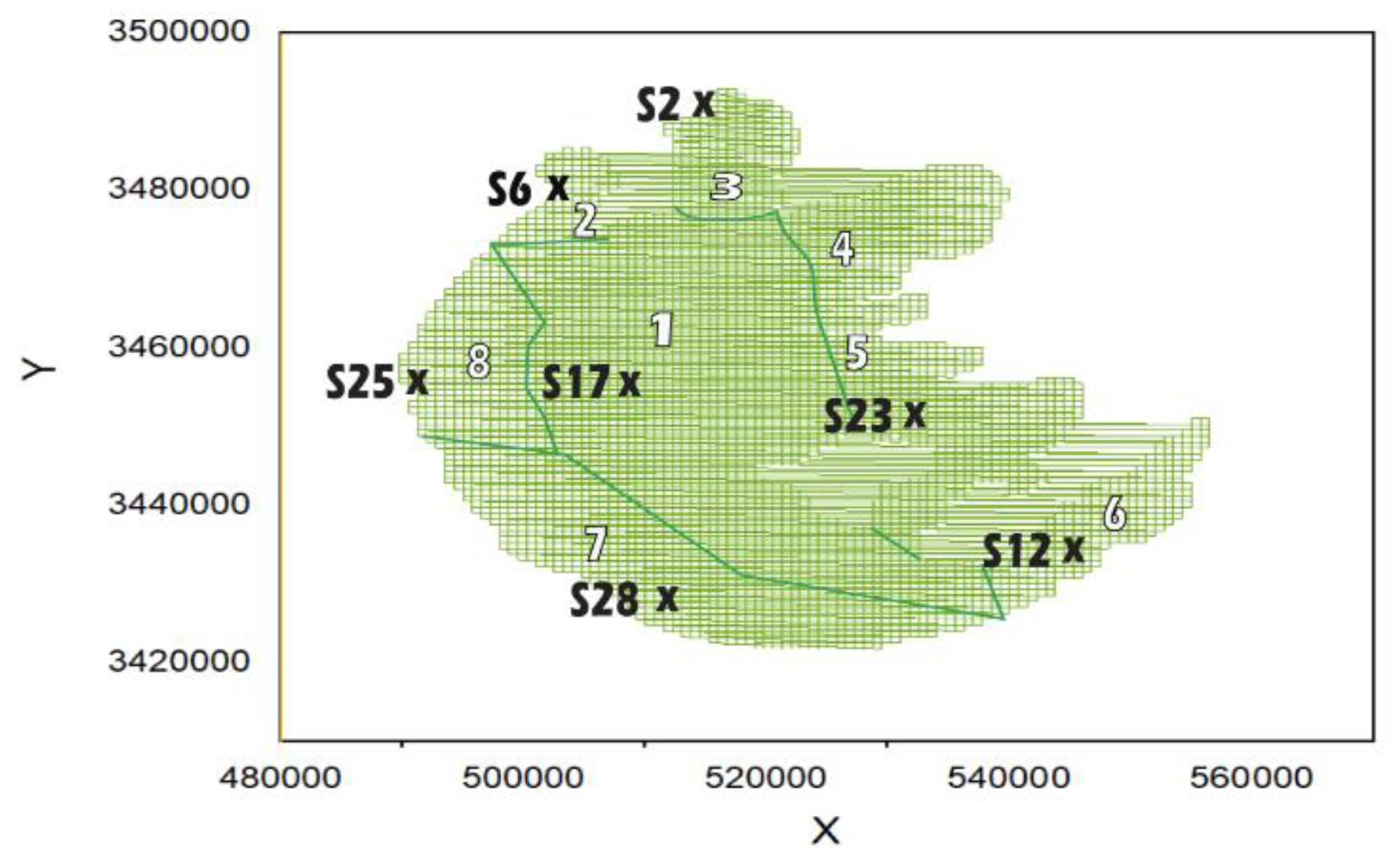
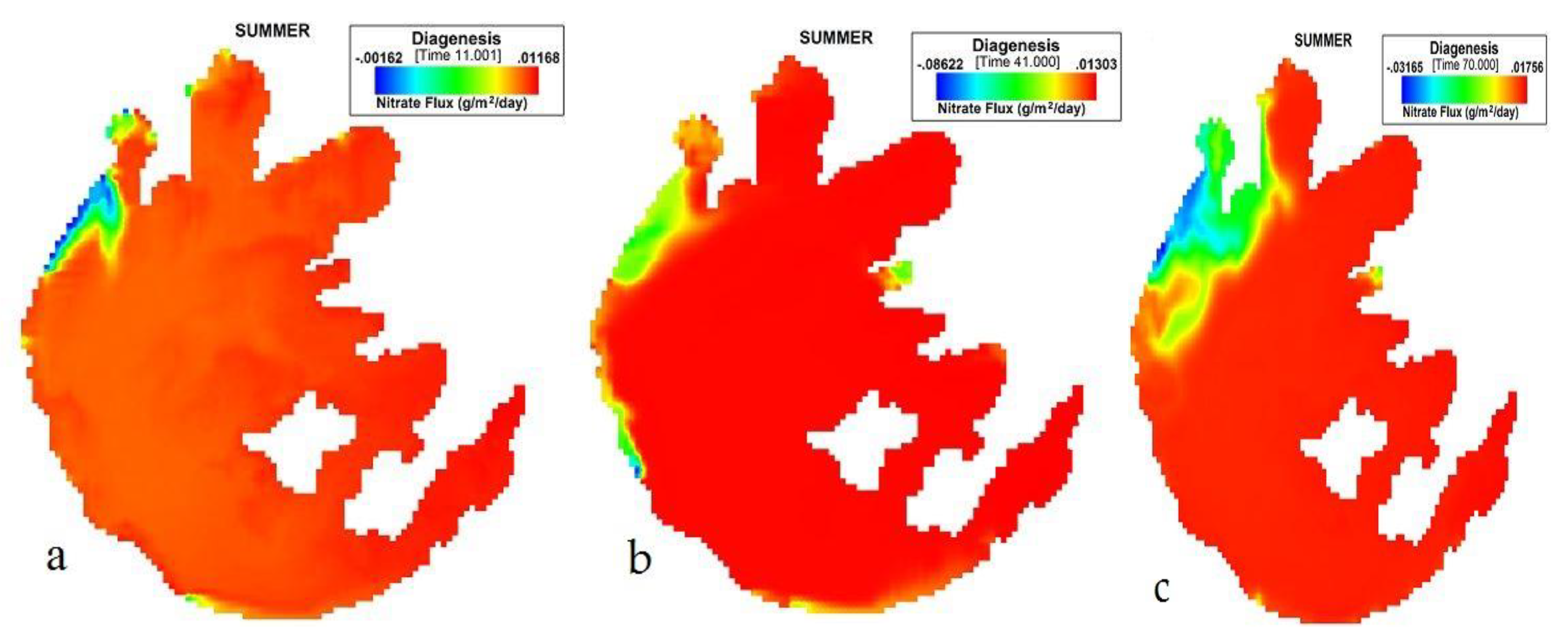

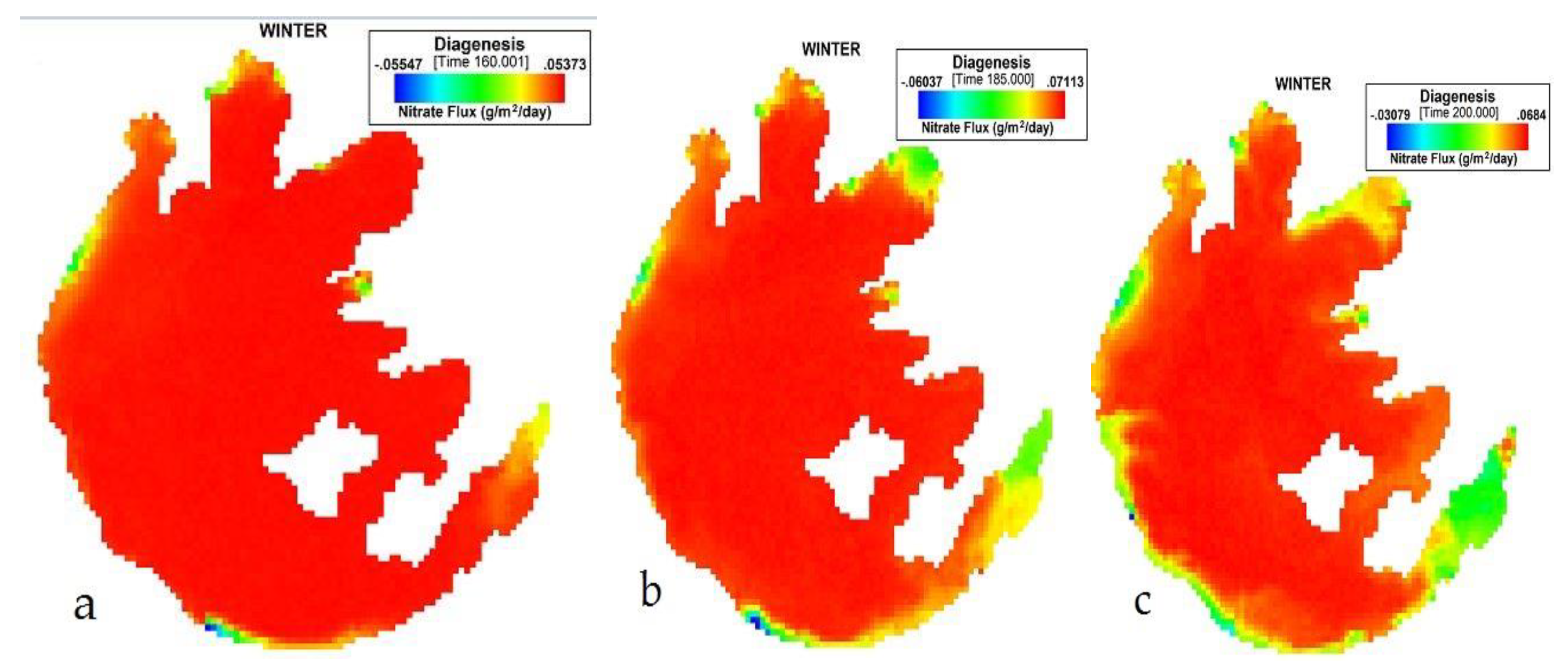
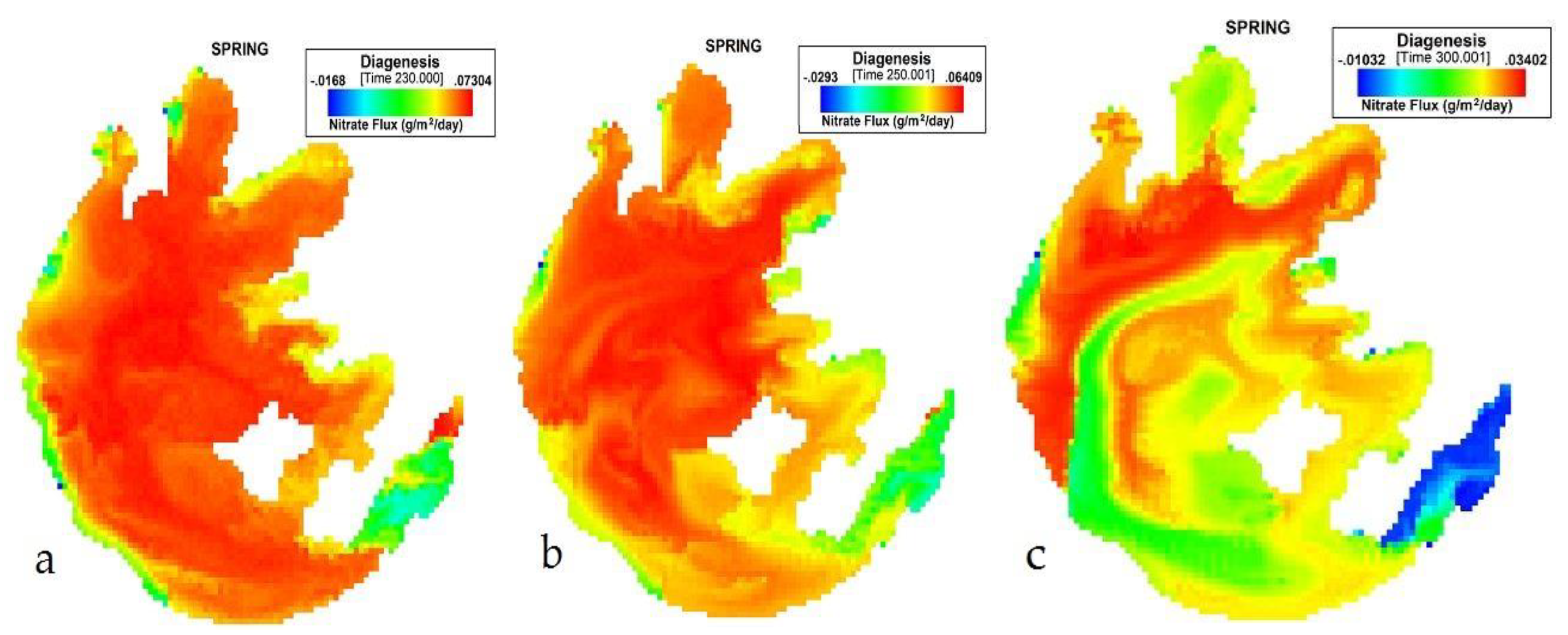
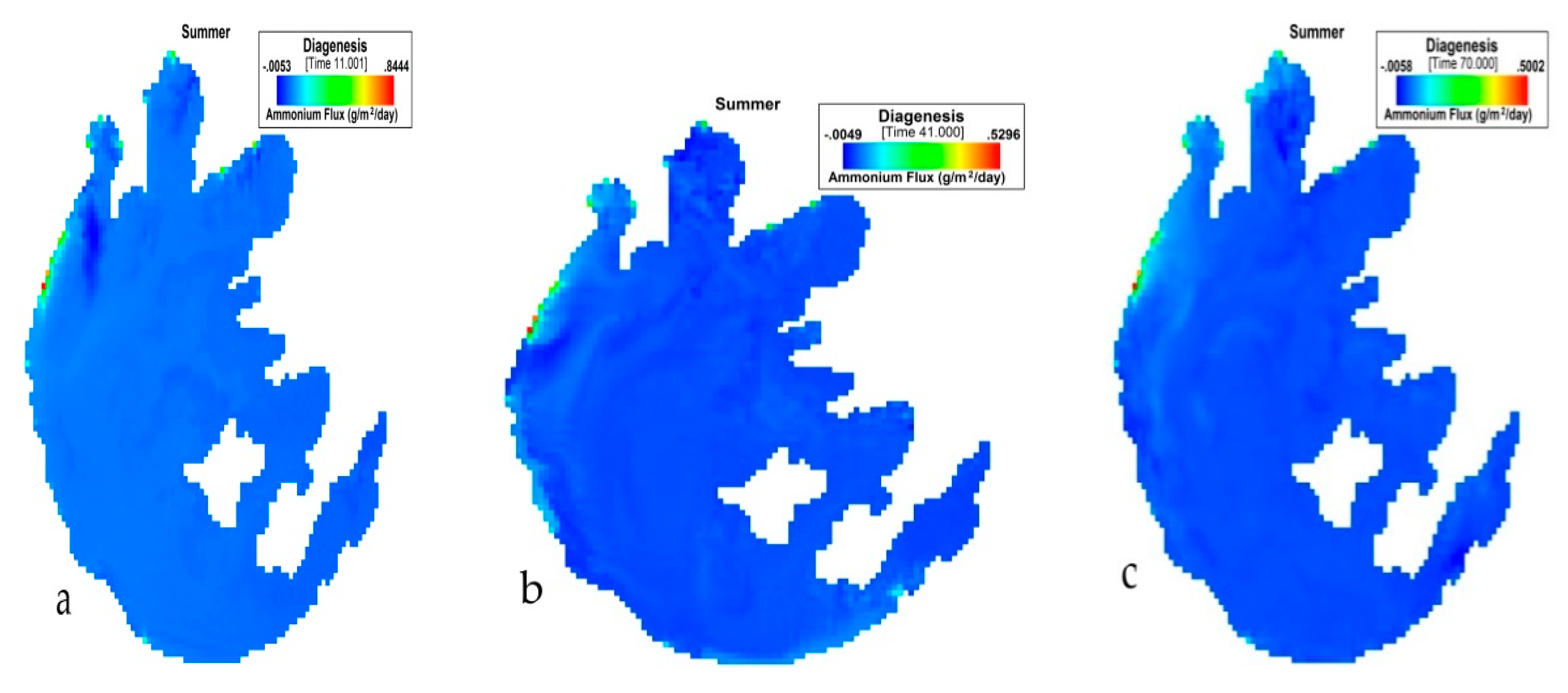



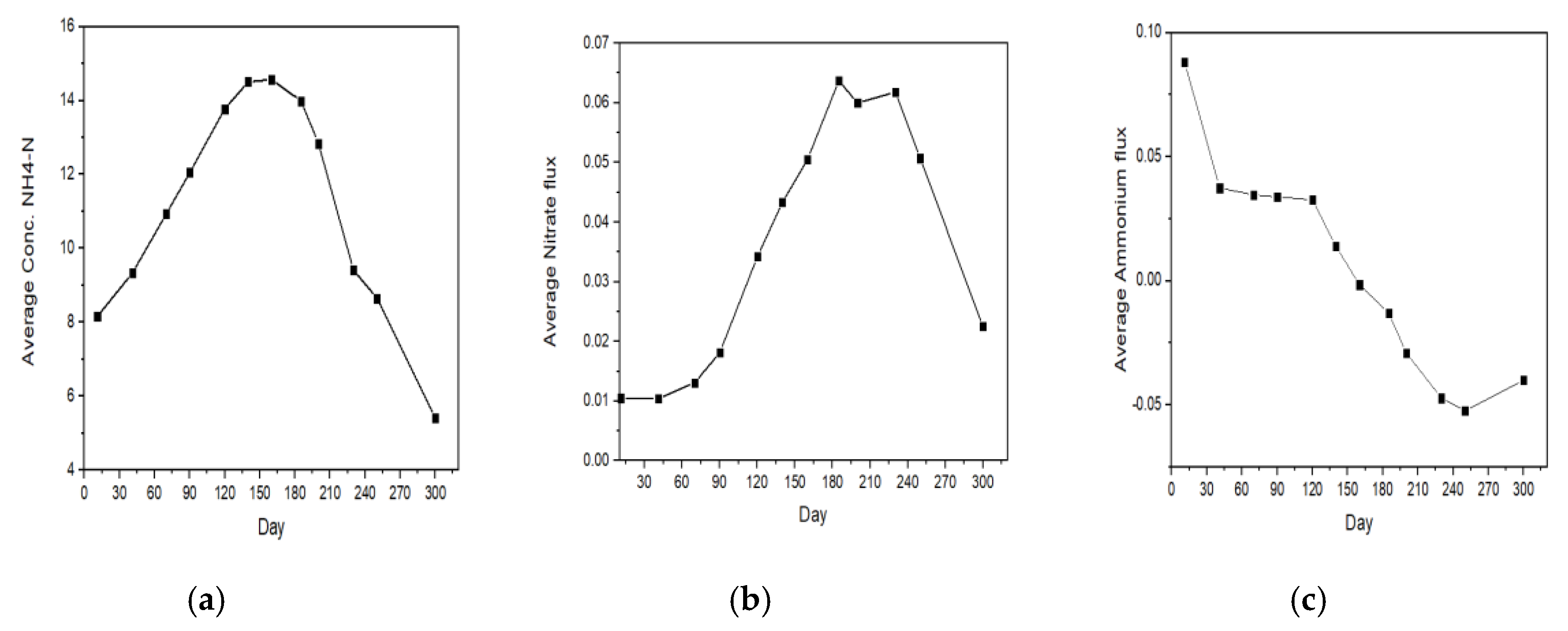

| No | Parameter | Meaning | Unit | Range |
|---|---|---|---|---|
| 1 | Dp | Particle mixing apparent diffusion coefficient | m2/d | <0.001–0.5 |
| 2 | θDpThDp | Constant for temperature adjustment for Dp | - | 1.07–1.117 |
| 3 | Hsed | Diagenesis sediment thickness | m | 0.10–0.20 |
| 4 | W2 | Sediment burial rate | cm/yr | 0.02–1.0 |
| 5 | θNH4/ThNH4 | Temperature coefficient for nitrification | - | 1.076–1.127 |
| 6 | KN03,1 | Reaction velocity for denitrification in the aerobic layer | m/d | 0.05–0.10 |
| 7 | θNO3/ThNO3 | Temperature coefficient for denitrification | - | 1.056–1.20 |
| 8 | KPON1 | Decay rate of PON at 20 °C for G1 class | 1/d | 0.019–0.066 |
| 9 | ThKN1 | Constant for temperature adjustment for KPON1 | - | 1.052–1.166 |
| 10 | ThKN2 | Constant for temperature adjustment for KPON2 | - | 1.052–1.166 |
| 11 | θKM,NH4 | Temperature coefficient for nitrification half-saturation constant | - | 1.125 |
| 12 | KPON2 | Decay rate of PON at 20degC for G2 class | 1/d | 0.0012–0.0088 |
| Time (Days) | Range (g/m2/Day) | Range (g/m3) | Range (g/m2/Day) | Average (g/m2/Day) | Range (g/m3) | Average (g/m2/Day) |
|---|---|---|---|---|---|---|
| NO3 Flux | Conc. NH4-N | NH4 Flux | NO3 Flux | Conc.NH4-N | NH4 Flux | |
| 11th | −0.0162–0.01168 | 7.469671–18.81496 | −0.005–0.844 | 0.0105 | 8.158883 | 0.08814 |
| 41st | −0.06622–0.01303 | 5.262655–19.0483 | −0.0049–0.5296 | 0.0104 | 9.332679 | 0.03746 |
| 70th | −0.03165–0.01756 | 9.191248–17.47765 | −0.0058–0.5002 | 0.0131 | 10.93654 | 0.0347 |
| 90th | −0.01081–0.0211 | 9.594671–19.50419 | 0.0187–0.4464 | 0.018149 | 12.0526 | 0.03385 |
| 120th | −0.04543–0.04031 | 4.2638–22.48205 | −0.033–0.4914 | 0.0342 | 13.78247 | 0.03268 |
| 140th | −0.03398–0.04587 | 6.443372–22.31578 | −0.0372–0.0746 | 0.0433 | 14.50533 | 0.01396 |
| 160th | −0.05547–0.5373 | 4.224813–22.38613 | −0.0685–0.3424 | 0.0505 | 14.57058 | −0.00146 |
| 185th | −0.06037–0.07113 | 4.278185–19.12033 | −0.0496–0.2956 | 0.0637 | 13.99708 | −0.01295 |
| 200th | −0.03079–0.0684 | 5.261141–18.6685 | −0.0575–0.2429 | 0.0600 | 12.8486274 | −0.02501 |
| 230th | −0.0163–0.07304 | 3.025818–13.67934 | −0.0871–0.2172 | 0.0618 | 9.413582 | −0.04715 |
| 250th | −0.0293–0.0649 | 5.151477–11.53736 | −0.0838–0.1551 | 0.0507 | 8.65485 | −0.05229 |
| 300th | −0.0102–0.03402 | 2.744903–9.846215 | −0.0515–0.081 | 0.0223 | 5.405481 | −0.03999 |
© 2020 by the authors. Licensee MDPI, Basel, Switzerland. This article is an open access article distributed under the terms and conditions of the Creative Commons Attribution (CC BY) license (http://creativecommons.org/licenses/by/4.0/).
Share and Cite
Sarpong, L.; Li, Y.; Norgbey, E.; Nwankwegu, A.S.; Cheng, Y.; Nasiru, S.; Nooni, I.K.; Setordjie, V.E. A Sediment Diagenesis Model of Seasonal Nitrate and Ammonium Flux Spatial Variation Contributing to Eutrophication at Taihu, China. Int. J. Environ. Res. Public Health 2020, 17, 4158. https://doi.org/10.3390/ijerph17114158
Sarpong L, Li Y, Norgbey E, Nwankwegu AS, Cheng Y, Nasiru S, Nooni IK, Setordjie VE. A Sediment Diagenesis Model of Seasonal Nitrate and Ammonium Flux Spatial Variation Contributing to Eutrophication at Taihu, China. International Journal of Environmental Research and Public Health. 2020; 17(11):4158. https://doi.org/10.3390/ijerph17114158
Chicago/Turabian StyleSarpong, Linda, Yiping Li, Eyram Norgbey, Amechi S. Nwankwegu, Yue Cheng, Salifu Nasiru, Isaac Kwesi Nooni, and Victor Edem Setordjie. 2020. "A Sediment Diagenesis Model of Seasonal Nitrate and Ammonium Flux Spatial Variation Contributing to Eutrophication at Taihu, China" International Journal of Environmental Research and Public Health 17, no. 11: 4158. https://doi.org/10.3390/ijerph17114158
APA StyleSarpong, L., Li, Y., Norgbey, E., Nwankwegu, A. S., Cheng, Y., Nasiru, S., Nooni, I. K., & Setordjie, V. E. (2020). A Sediment Diagenesis Model of Seasonal Nitrate and Ammonium Flux Spatial Variation Contributing to Eutrophication at Taihu, China. International Journal of Environmental Research and Public Health, 17(11), 4158. https://doi.org/10.3390/ijerph17114158








